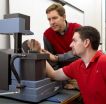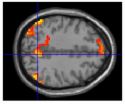(Press-News.org) AMES, Iowa – Michael Kessler has worked with polymers that repair themselves when they crack. And he's worked with polymers made from vegetable oils. Now he's working to combine the two technologies.
Kessler, an Iowa State University associate professor of materials science and engineering and an associate of the U.S. Department of Energy's Ames Laboratory, is researching and developing biorenewable polymers capable of healing themselves as they degrade and crack.
"If successful, the results of this research will provide biorenewable alternatives to petroleum-based resins," says a summary of Kessler's research project. Successfully developing the concept "should have a huge impact economically and environmentally."
Kessler's research project is supported by a five-year, $400,000 grant from the National Science Foundation's Faculty Early Career Development Program.
Kessler started working with self-healing materials as a doctoral student at the University of Illinois at Urbana-Champaign. He was part of a research team that in February 2001 published an article in the journal Nature that helped launch the field.
The technology has evolved into a system that embeds catalysts and microcapsules containing a liquid healing agent within a composite. As cracks develop in the composite, they rupture the microcapsules and release the healing agent. The healing agent contacts the catalyst and reacts by forming 3-D polymer chains that fill the cracks. That increases material lifetimes and reduces maintenance.
Visit his office, and Kessler will pull out a little container half filled with what looks like fine yellow powder. Those are the hollow microcapsules that make the self-healing process work, he said. (They're also the same technology behind scratch-and-sniff perfume ads.)
When Kessler joined Iowa State and the Ames Laboratory in 2005, he started working with Richard Larock, a Distinguished Professor of Chemistry and associate of the Ames Laboratory, to develop biorenewable polymers from vegetable oils.
Larock has invented and patented a process for producing various bioplastics from inexpensive natural oils, which make up 40 percent to 80 percent of the plastics. Larock has said the plastics have excellent thermal and mechanical properties and are very good at dampening noises and vibrations. They're also very good at returning to their original shapes when they're heated.
But can they be developed into a self-healing material?
Early results show there's laboratory work to do. Kessler's research has found that a healing agent for a polymer based on tung oil works too fast. Kessler and Peter Hondred, an Iowa State graduate student in materials science and engineering, are working to slow the agent for better healing.
The researchers are also working to develop encapsulating techniques that work with biorenewable polymers. And they're working to develop bio-based healing agents.
Despite the challenges, Kessler thinks there is potential to develop self-healing, biorenewable materials. He said the big question is whether researchers can push the healing efficiency of biorenewable polymers close to the 90 percent of standard composites.
INFORMATION:
Contacts:
Michael Kessler, Materials Science and Engineering and Ames Laboratory, 515-294-3101, mkessler@iastate.edu
Mike Krapfl, News Service, 515-294-4917, mkrapfl@iastate.edu
Iowa State, Ames Lab researcher developing bio-based polymers that heal cracks
2011-01-07
ELSE PRESS RELEASES FROM THIS DATE:
Extracting cellular 'engines' may aid in understanding mitochondrial diseases
2011-01-07
VIDEO:
Extracting mitochondria from a human cell (larger object on bottom right) is a tricky process. NIST researchers recently developed techniques that can surgically remove these tiny cellular engines, potentially enabling...
Click here for more information.
Medical researchers who crave a means of exploring the genetic culprits behind a host of neuromuscular disorders may have just had their wish granted by a team working at the National Institute of Standards and Technology ...
Faulty 'off-switch' stops children with ADHD from concentrating
2011-01-07
Brain scans of children with attention-deficit/hyperactivity disorder (ADHD) have shown for the first time why people affected by the condition sometimes have difficulty in concentrating. The study, by experts at The University of Nottingham, may explain why parents often say that their child can maintain concentration when they are doing something that interests them, but struggles with boring tasks.
Using a 'Whac-a-Mole' style game, researchers from the Motivation, Inhibition and Development in ADHD Study (MIDAS) group found evidence that children with ADHD require ...
NIST telescope calibration may help explain mystery of universe's expansion
2011-01-07
Is the expansion of the universe accelerating for some unknown reason? This is one of the mysteries plaguing astrophysics, and somewhere in distant galaxies are yet-unseen supernovae that may hold the key. Now, thanks to a telescope calibrated by scientists from the National Institute of Standards and Technology (NIST), Harvard University and the University of Hawaii, astrophysicists can be more certain of one day obtaining an accurate answer.
The NIST scientists traveled to the summit of Haleakala volcano in Hawaii to fine-tune the operation of billions of light-collecting ...
IPv6 guide provides path to secure deployment of next-generation Internet protocol
2011-01-07
As the day draws nearer for the world to run out of the unique addresses that allow us to use the Internet—now predicted to happen by the end of 2012—researchers at the National Institute of Standards and Technology (NIST) have issued a guide for managers, network engineers, transition teams and others to help them deploy the next generation Internet Protocol (IPv6) securely.
Guidelines for the Secure Deployment of IPv6 (NIST Special Publication 800-119), describes the features of IPv6 and the possible related security impacts, provides a comprehensive survey of mechanisms ...
2 publications recommend organization-wide IT security risk management
2011-01-07
Two new draft publications from the National Institute of Standards and Technology (NIST) provide the groundwork for a three-tiered risk-management approach that encompasses computer security risk planning from the highest levels of management to the level of individual systems. The draft documents have been released for public comment.
Both publications are a part of NIST's risk management guidelines, which have been developed in support of the Federal Information Security Management Act (FISMA), and adopted government wide to improve the security of government systems ...
Princeton scientists construct synthetic proteins that sustain life
2011-01-07
In a groundbreaking achievement that could help scientists "build" new biological systems, Princeton University scientists have constructed for the first time artificial proteins that enable the growth of living cells.
The team of researchers created genetic sequences never before seen in nature, and the scientists showed that they can produce substances that sustain life in cells almost as readily as proteins produced by nature's own toolkit.
"What we have here are molecular machines that function quite well within a living organism even though they were designed ...
High dietary fat, cholesterol linked to increased risk of breast cancer
2011-01-07
(PHILADELPHIA) Elevated fat and cholesterol levels found in a typical American-style diet play an important role in the growth and spread of breast cancer, say researchers at the Kimmel Cancer Center at Jefferson.
The study, published in the January issue of The American Journal of Pathology, examines the role of fat and cholesterol in breast cancer development using a mouse model. The results show that mice fed a Western diet and predisposed to develop mammary tumors, can develop larger tumors that are faster growing and metastasize more easily, compared to animals eating ...
Drinking recycled water?
2011-01-07
Madison, WI December 28, 2010 – The Australian Government National Water Commission funded a study to establish an approach to assess the quality of water treated using managed aquifer recharge. Researchers at Australia's CSIRO Land and Water set out to determine if the en product would meet standard drinking water guidelines.
At the Parafield Aquifer Storage, Transfer and Recovery research project in South Australia, the team of scientists harvested storm water from an urban environment, treated it in a constructed wetland, stored it in an aquifer, and then recovered ...
Fermi's Large Area Telescope sees surprising flares in Crab Nebula
2011-01-07
Menlo Park, Calif. — The Crab Nebula, one of our best-known and most stable neighbors in the winter sky, is shocking scientists with a propensity for fireworks—gamma-ray flares set off by the most energetic particles ever traced to a specific astronomical object. The discovery, reported today by scientists working with two orbiting telescopes, is leading researchers to rethink their ideas of how cosmic particles are accelerated.
"We were dumbfounded," said Roger Blandford, who directs the Kavli Institute for Particle Astrophysics and Cosmology, jointly located at ...
NOAA-led team measures atmosphere's self-cleaning capacity
2011-01-07
An international, NOAA-led research team took a significant step forward in understanding the atmosphere's ability to cleanse itself of air pollutants and some other gases, except carbon dioxide. The issue has been controversial for many years, with some studies suggesting the self-cleaning power of the atmosphere is fragile and sensitive to environmental changes, while others suggest greater stability. And what researchers are finding is that the atmosphere's self-cleaning capacity is rather stable.
New analysis published online today in the journal Science shows that ...



